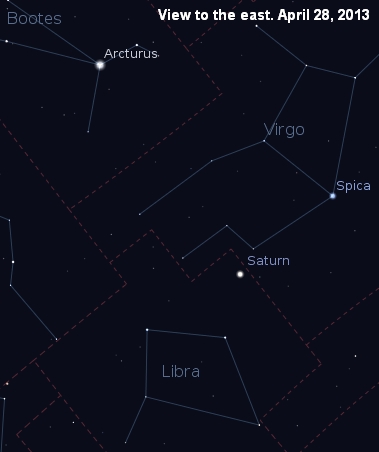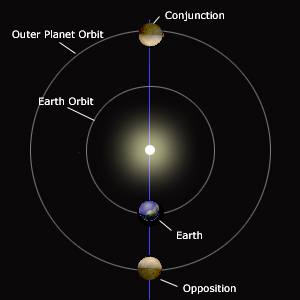¡SkyCaramba! Weekly astronomy blog for the week ending April 27, 2013
 This is the best time of this year to see the planet Saturn. It’s closest to Earth and up all night. When a planet is in such circumstances, it’s said to be in opposition because it’s opposite in the sky from the sun. If you’re looking for Saturn at ten at night, imagine where the sun would be at ten in the morning and there you’ll find the ringed planet.
This is the best time of this year to see the planet Saturn. It’s closest to Earth and up all night. When a planet is in such circumstances, it’s said to be in opposition because it’s opposite in the sky from the sun. If you’re looking for Saturn at ten at night, imagine where the sun would be at ten in the morning and there you’ll find the ringed planet.
The exact date of opposition this year is April 28. But if your skies are cloudy that morning or that night or if there’s some other reason you can’t look at the night sky then, you don’t have to worry about missing the show. The planet will look just as good now until several weeks later.
Look in the east after sunset. You’ll see three bright objects rising. The orange star Arcturus will be on the left. Bluish Spica will be on the right. Yellow Saturn will be below them to the right. If you look in the west before sunrise, you’ll see the flipped image of what I just described with Arcturus on the right, Spica on the left, and Saturn below them and to the left.
Look at the images accompanying this article for further guidance. If you’re still not sure you’re looking at Saturn, watch from night to night. The object that moves just a little bit is the planet. Also, watch the moon pass south of the ringed planet on the 26th.
 The best view will be in a telescope. You’ll know you’re seeing Saturn as soon as you see its rings. You may want magnification around 30x or greater to see them. The more magnification you use, the more likely you are to see the Cassini Division, named after astronomer Jean Cassini. It’s a gap between the other chunks of rock orbiting Saturn and comprising the rings. Right now, there’s a spacecraft named Cassini orbiting Saturn, taking pictures, and gathering other data about the planet and its moons.
The best view will be in a telescope. You’ll know you’re seeing Saturn as soon as you see its rings. You may want magnification around 30x or greater to see them. The more magnification you use, the more likely you are to see the Cassini Division, named after astronomer Jean Cassini. It’s a gap between the other chunks of rock orbiting Saturn and comprising the rings. Right now, there’s a spacecraft named Cassini orbiting Saturn, taking pictures, and gathering other data about the planet and its moons.
And speaking of Saturn’s moons, you’re also more likely to see them with greater magnification. Titan is thought to be made of water ice and rock. An atmosphere hides its surface. Mimas is also made of mostly water ice with a little rock, but we’re able to see its cratered surface clearly. One crater is so big, at first glance, you might think all of Mimas is the crater! There are about five dozen moons orbiting the ringed planet. However, you won’t see most of them with an Earth based telescope.
 Saturn is 8.8 earth-sun distances from us right now. In November, when the planet has swung around to the other side of the sun, it will be 10.8 earth-sun distances away. Then, it will be in the same part of the sky as the sun, a position called conjunction. Of course, it will be impossible to see the planet. You have several months of Saturn rising earlier and earlier farther west in the sky each night until it’s setting at sunset. That’s a lot of time to get a good view of the planet.
Saturn is 8.8 earth-sun distances from us right now. In November, when the planet has swung around to the other side of the sun, it will be 10.8 earth-sun distances away. Then, it will be in the same part of the sky as the sun, a position called conjunction. Of course, it will be impossible to see the planet. You have several months of Saturn rising earlier and earlier farther west in the sky each night until it’s setting at sunset. That’s a lot of time to get a good view of the planet.
¡SkyCaramba!
Here are some links to more information about Saturn and its moons. Images on this page are from NASA or are simulated with Stellarium.
http://www.nakedeyeplanets.com/saturn-orbit.htm
http://www.newsday.com/columnists/other-columnists/sky-watch-saturn-at-opposition-1.5098921
http://earthsky.org/astronomy-essentials/give-me-five-minutes-ill-give-you-saturn